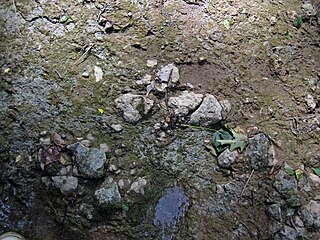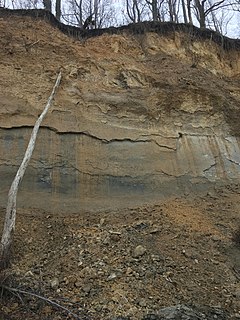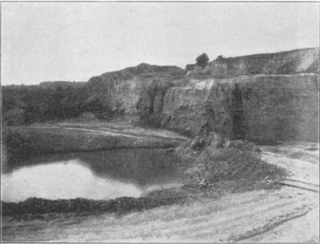
Wills Creek Formation is a mapped Silurian bedrock unit in Pennsylvania, Maryland, Virginia, and West Virginia.

The Conemaugh Group is a geologic group in West Virginia, Pennsylvania, Ohio, and Maryland. It preserves fossils dating back to the Carboniferous period.

The Monongahela Formation is a geologic formation in West Virginia, Pennsylvania, Ohio, and Maryland. It preserves fossils dating back to the Carboniferous and Permian periods.
The Oriskany Sandstone is a Middle Devonian age unit of sedimentary rock found in eastern North America. The type locality of the unit is located at Oriskany Falls in New York. The Oriskany Sandstone extends throughout much of the Appalachian Basin.
The Williamsport Sandstone is a sandstone geologic formation in West Virginia, Virginia, Pennsylvania, and Maryland. the formation includes the Cedar Creek Limestone member. Near Cumberland, Maryland it includes the Cedar Creek Limestone member. It preserves fossils dating back to the Silurian period.

The Greene Formation is a geologic formation in West Virginia, Ohio, Maryland, Virginia and Pennsylvania. It preserves fossils dating back to the Permian period.
The Lockport Dolomite is a geologic formation in Ohio. It preserves fossils dating back to the Silurian period.

The Harrodsburg Limestone is a geologic formation, a member of the Sanders Group of Indiana Limestone, of Mississippian age. It was named for Harrodsburg in southern Monroe County, Indiana by T. C. Hopkins and C. E. Siebenthal. It is made up primarily of calcarenite and calcirudite. It also may include some beds of dolomite and shale.

The Chesapeake Group is a geologic group in Maryland, Virginia, Delaware, and North Carolina. It preserves mainly marine fossils dating back to the Miocene and Pliocene epochs of the Neogene period. This group contains one of the best studied fossil record of Neogene oceans in the world. Professional Paleontologists and amateur fossil hunters alike collect from this group intensely. The Calvert Cliffs stretch the length of Calvert County, Maryland and provide the best continuous stretch of the Calvert, Choptank, and St. Marys Formations. Ward (1985) recommended including the Old Church Formation in this group.
The Powell Formation or Powell Dolomite is a geologic formation in northern Arkansas, southeast Missouri and Virginia. It contains gastropod, cephalopod, and trilobite fossils dating back to the Ordovician Period.

The Rockdale Run Formation is a geologic formation in Maryland, Pennsylvania, Virginia and West Virginia. It preserves fossils dating back to the Ordovician period.
The Chepultepec Formation, is an Early Ordovician-age geological formation in the Appalachian regions of Eastern North America. Also known as the Chepultepec Dolomite, it is a unit of the Upper Knox Group, overlying the Copper Ridge Dolomite and underlying the Longview-Kingsport-Mascot sequence. The Chepultepec Formation is a primarily limestone and dolomite formation, the earliest formation of the Ordovician period in its area. Further north, it is equivalent to the Stonehenge Formation of the Beekmantown Group. The formation was first described from Allgood, Alabama, and has also been found in Tennessee and Virginia. Allgood was originally named "Chepultepec", providing its name to the formation as well. In Virginia, the Chepultepec Formation has a habit of forming large natural arches, including Natural Tunnel in Scott County and Natural Bridge in Rockbridge County.
The Cotter Formation is a geologic formation in Arkansas, Missouri, Oklahoma and in Virginia. It preserves fossils dating back to the Ordovician period.

The Patapsco Formation is a geologic formation of varigated clays, sandy clays, and sand in Virginia, the District of Columbia, Maryland, Delaware, Pennsylvania, and in the subsurface of New Jersey. It preserves fossils such as plants and molluscs dating back to the Cretaceous period.
The Helderberg Formation is a geologic formation in Pennsylvania, Maryland and West Virginia. It preserves fossils dating back to the Devonian period.
The Java Formation is a geologic formation in Kentucky, New York, Ohio, Pennsylvania, Tennessee, Virginia, West Virginia. It preserves fossils dating back to the Devonian period. The formation comprises the Pipe Creek Shale, Wiscoy Sandstone Member in New York, and Hanover Shale Member except in Tennessee.

The Kinzers Formation is a geologic formation in Pennsylvania. It preserves fossils dating back to the Cambrian Period.
The Fish Haven Dolomite is an Ordovician period geologic formation in southern Idaho, northeastern Nevada, and northwestern Utah.
The Ely Springs Dolomite is an Ordovician period geologic formation in the Southwestern United States.
The Huntersville Chert or Huntersville Formation is a Devonian geologic formation in the Appalachian region of the United States. It is primarily composed of mottled white, yellow, and dark grey chert, and is separated from the underlying Oriskany Sandstone by an unconformity. The Huntersville Chert is laterally equivalent to the Needmore Shale, which lies north of the New River. It is also laterally equivalent to a sandy limestone unit which is often equated with the Onondaga Limestone. These formations are placed in the Onesquethaw Stage of Appalachian chronostratigraphy, roughly equivalent to the Emsian and Eifelian stages of the broader Devonian system.









